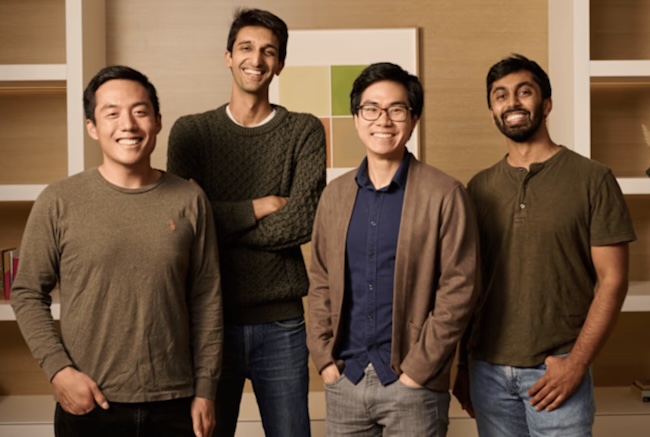10 Most Innovative Asian AI Startups of the Past Decade - Part 1
By Terry Bu | 01 Oct, 2025
These Asian-founded startups introduce AI uses cases that boggle the imagination and stretch the limits of socially acceptable uses.
These 10 AI startups were founded by Asian leaders putting AI technology to fascinating uses likely to have groundbreaking impact on various industries. Some also illustrate the societal risks and challenges that AI development is likely to pose in coming years.
Perplexity CEO Aravind Srinivas and Chief Strategy Officer Johnny Ho are two of the startup's four founders.
1. Perplexity AI
Perplexity was founded in 2022 by a team of four leaders. Among them are CEO Aravind Srinivas, a PhD graduate from University of Caliornia, Berkeley who previously held research positions at OpenAI, Google Brain, and DeepMind with expertise in machine learning and artificial intelligence. In 2024 Time magazine named Srinivas one of the "TIME100 Most Influential People in AI.”
Another co-founder is the startup's Chief Strategy Officer Johnny Ho currently. Ho recently spoke at MIT about the early beginnings of Perplexity AI when it actually began as a “text-to-SQL” product that translates natural language statements into Structured Query Language (SQL) commands that allow non-technical users to interact with SQL databases and retrieve information using everyday language, eliminating the need for specialized SQL knowledge.
Perplexity AI is currently backed by Jeff Bezos’s investment firm, Bezos Expeditions, and other notable investors such as Nvidia and Shopify co-founder Tobias Lütke, further validating the company's potential.
The V-BAT is Shield AI's high-endurance, fixed-wing VTOL unmanned aircraft in use by the US military around the world.
2. Shield AI
The concept for Shield AI was born when Brandon Tseng, a Navy SEAL fighting in Afghanistan, asked himself “What does the military of 2030 look like?”
Tseng foresaw that AI pilots would eventually power every military asset: aircraft, drones, ships, satellites, and submarines. Shield's mission is to provide the military with the best of AI and autonomy technology to realize that vision. The company now employs machine learning to develop sophisticated defense software and tools that can power drones and unmanned aircrafts. Its use cases are diverse including reconnaissance in close-quarters combat.
It was co-founded by brothers Ryan Tseng (former CEO and current President/Chief Strategy Officer) and Brandon Tseng (Current President), and is based in San Diego, California. Its clients include the United States Special Operations Command, US Air Force, US Marine Corps, US Navy and several international militaries.
With seed fund of $100,000 gathered from friends and family the founders embarked on goal of producing intelligent systems to protect service members and civilians. They began in 2015 by building a prototype of their flagship Nova drone. Shield has already gained recognition by developing the V-Bat, a vertical take-off and landing reconnaissance unmanned aerial vehicle, for the United States Navy.
V-BAT has the ability to operate without GPS or communications while possessing precision targeting capabilities that have provided a decisive advantage over other unmanned aerial vehicles (UAVs). It has been deployed all over the world, including the Middle East, the Black Sea, the Carribean and Ukraine.
3. Cartesia.ai
Cartesia (https://cartesia.ai/) calls itself the “fastest, ultra-realistic voice AI platform”. It's a leading Voice AI foundation model research and development company powering the next generation of Voice AI applications such as real-time and conversational experiences, dubbing, narration, AI avatars, and more.
Cartesia is led by a group of Stanford researchers that includes CEO Karan Goel from India, and his Stanford labmates Albert Gu, Arjun Desai, and Brandon Yang. Cartesia's public website allows users to experiment with its AI voices for free across multiple languages (currently 15, including English, Spanish, Korean, Japanese, Chinese, Hindi, French, Italian, Swedish, and more).
Its Sonic product prides itself on having the lowest latency of any AI voice model — meaning it performs extremely quickly. When used for business voice agents it can spend more time understanding, thinking, and acting on user inputs. Its voice solution is now being applied to business use cases such as handling sales lead qualification, appointment scheduling and reminders, collections, confirmations, global localization and translation and more.
I spent some time with its voice tools platform, trying out its Instant Clone, Voice Changer and Localize a Voice features. The UI was intuitive. As the names suggest, you can do entertaining things with voice files, like creating an instant clone of your own voice after speaking into the microphone for 5 seconds and then producing an AI voice that reads in different languages in your exact voice. For example, I could speak in English for about 5 seconds into the microphone and then clone a voice that speaks perfect greetings in Spanish, French or Chinese.
You can also blend your voice with other AI voices or “design your voice” by adjusting different emotion parameters. With this tool, I could easily imagine the AI voice landscape evolving in the future for businesses to try to create their own unique business voice that best match their brand.

Cartesia was founded by CEO Karan Goel from India and his Stanford labmates Albert Gu, Arjun Desai and Brandon Yang.
Asian American Success Stories
- The 130 Most Inspiring Asian Americans of All Time
- 12 Most Brilliant Asian Americans
- Greatest Asian American War Heroes
- Asian American Digital Pioneers
- New Asian American Imagemakers
- Asian American Innovators
- The 20 Most Inspiring Asian Sports Stars
- 5 Most Daring Asian Americans
- Surprising Superstars
- TV’s Hottest Asians
- 100 Greatest Asian American Entrepreneurs
- Asian American Wonder Women
- Greatest Asian American Rags-to-Riches Stories
- Notable Asian American Professionals

